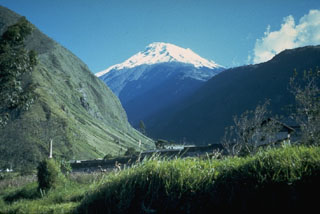Report on Tungurahua (Ecuador) — 3 September-9 September 2014
Smithsonian Institution / US Geological Survey
Weekly Volcanic Activity Report, 3 September-9 September 2014
Managing Editor: Sally Sennert.
Please cite this report as:
Global Volcanism Program, 2014. Report on Tungurahua (Ecuador) (Sennert, S, ed.). Weekly Volcanic Activity Report, 3 September-9 September 2014. Smithsonian Institution and US Geological Survey.
Tungurahua
Ecuador
1.467°S, 78.442°W; summit elev. 5023 m
All times are local (unless otherwise noted)
During 3-9 September IG reported moderate-to-high activity from Tungurahua. Explosions were observed most days during clear conditions, but also heard during episodes of rumbling during 4-6 September.
On 3 September gray and black ashfall was reported in the areas of Manzano (8 km SW), Choglontus (13 km WSW), Tisaleo (29 km NW), Quero Alto (20 km NW), and Quinchicoto. In the afternoon a pyroclastic flow descended 500 m from the crater and explosions were detected during 1700-1900. Ashfall was also noted on 5 September in the towns of Manzano and Palitahua (6 km SSW). At 1210 an ash plume reached 1,500 m above the crater and drifted both W and E.
In the morning of 6 September an incandescent plume was observed rising from the summit. Ash drifted W and later SW, and 0.5 mm of black ash accumulated in the areas of Penipe (15 km SW), Puela (8 km SW), Pillate (8 km W), Galán (WNW), and to the S of Quero (20 km NW). The following day ashfall was reported in Palitagua (SW), Manzano, and Bilbao (8 km W).
The MODIS sensor onboard the Aqua satellite detected a thermal anomaly from the region of Tungurahua’s summit on 7 September.
On 8 September cloudy conditions persisted, but in the afternoon an ash plume was visible drifting NW; ashfall was reported from Cevallos (23 km NW), Quero, Mocha (25 km W), Pillate, and Tisaleo. Black ashfall was reported in the area of Pillate on the following day.
Geological Summary. Tungurahua, a steep-sided andesitic-dacitic stratovolcano that towers more than 3 km above its northern base, is one of Ecuador's most active volcanoes. Three major edifices have been sequentially constructed since the mid-Pleistocene over a basement of metamorphic rocks. Tungurahua II was built within the past 14,000 years following the collapse of the initial edifice. Tungurahua II collapsed about 3,000 years ago and produced a large debris-avalanche deposit to the west. The modern glacier-capped stratovolcano (Tungurahua III) was constructed within the landslide scarp. Historical eruptions have all originated from the summit crater, accompanied by strong explosions and sometimes by pyroclastic flows and lava flows that reached populated areas at the volcano's base. Prior to a long-term eruption beginning in 1999 that caused the temporary evacuation of the city of Baños at the foot of the volcano, the last major eruption had occurred from 1916 to 1918, although minor activity continued until 1925.
Sources: Instituto Geofísico-Escuela Politécnica Nacional (IG-EPN), Hawai'i Institute of Geophysics and Planetology (HIGP) Thermal Alerts Team

